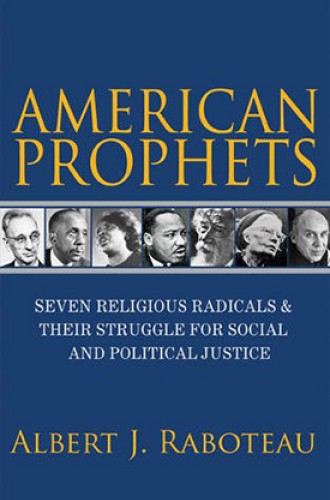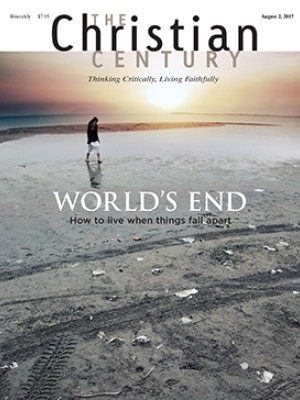What does a prophet look like?
Albert Raboteau profiles seven people who shaped the theology and practice of activism in 20th-century America.
Albert Raboteau’s short history of prophecy in 20th-century America hints at what a prophet might look like in today’s world. Raboteau is a historian of African American religion who taught at Princeton University. The book is based on a course he taught on religious radicals, and this pedagogical origin makes it useful as a resource for preaching or adult education.
The titular prophets are seven Americans, an interfaith and ecumenical group, all active in the middle third of the 20th century. Raboteau profiles Abraham Joshua Heschel, rabbi and biblical scholar; A. J. Muste, pacifist and head of the Fellowship of Reconciliation; Dorothy Day, founder of the Catholic Worker Movement; Howard Thurman, theologian and advocate for interracial community; Thomas Merton, Catholic contemplative and interfaith activist; Martin Luther King Jr., leader of the civil rights movement; and Fannie Lou Hamer, voting rights advocate and leader of the Mississippi Freedom Democratic Party. Each prophet is the subject of a chapter that features a mixture of biography and analysis of writings and speeches.
Read our latest issue or browse back issues.
The stories of these seven prophets share significant themes. Each of them was an activist who worked to address racism, materialism, and militarism. While Raboteau’s book is not about race, the civil rights movement is his paradigm of religious activism for justice.
Although each prophet demonstrated deep faith and had mystical experiences, they all had vexed relations with their religious traditions. They criticized or were criticized by official organizations. They created new movements outside institutional structures. Muste’s experience was typical, Raboteau suggests: Muste’s mystical experiences confirmed his faith “when doubt about traditional doctrine and disappointment over ecclesiastical complicity with the status quo shook his commitment to Christianity.” Struggling against institutions has long been a hallmark of prophets.
These biographies also draw attention to the personal, political, and intellectual relationships between the seven figures. Raboteau’s prophets met at conferences, published in each other’s magazines, and influenced each other’s thought. Those connections draw the individual chapters together into a single trajectory and make the book useful to historians looking to understand American religious networks in the middle of the 20th century.
Most importantly, Raboteau reveals the importance of spiritual practice for these prophets. Each narrative features a mystical experience and the development of contemplative practice. The link between contemplation and activism, Raboteau argues, remains essential for social change. “The struggle to overcome ‘the giant triplets of racism, excess materialism, and militarism’ remains arduous,” he writes.
It requires the radical realization that alienation from our true selves, fed and disguised by mass consumerism, leads to violence and the reduction of persons into things. Contemplation and action need to be joined lest our activism becomes merely another form of violence and our contemplation another form of self-gratification.
As this realization shaped the spirituality of Raboteau’s historical prophets, so might it influence the development of today’s prophets.
Several of Raboteau’s figures are already the subject of numerous biographies or autobiographies. His telling, however, highlights their contribution to the theology and practice of activism in 20th- century America. Heschel served both Jews and Christians as a theorist and activator of the prophetic role. Muste demonstrated through his life a willingness to suffer to achieve a more just society. Raboteau calls Merton the epitome of an activist, noting that his activism emerged because he was a contemplative.
The greatest revelation here is Hamer. Unlike many of the other figures, she was not a scholar or a clergyman but a prophetic preacher with authority rooted in her experience. Hamer is best known for leading the Mississippi Freedom Democratic Party during the 1964 party convention, but Raboteau puts that episode in the larger context of her life. He highlights the prominence of the Bible and hymns in her speaking and writing, even in her descriptions of arrest and torture, echoing the central place of Christian language in the experience of poor black Mississippians like herself. As she taught the participants in 1964’s Freedom Summer campaign the importance of religion to the black people of the South, she spoke with “authenticity, a moral authority that can only come from suffering.”
Raboteau concludes with a brief reflection on the importance of prophetic witness in times like ours. His seven prophets, he notes, kept their hope alive by remembering the narratives of Exodus and resurrection, and by speaking again the words of earlier prophets like Francis of Assisi, Schweitzer, and Gandhi. As they confronted the injustice around them, they drew on “the divine pathos for humanity that burns like fire in the prophet’s bones.” Hope, compassion, activism, and contemplation: these are the prophetic principles, both in the middle of the 20th century and in our own strange times.







